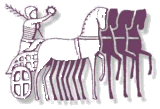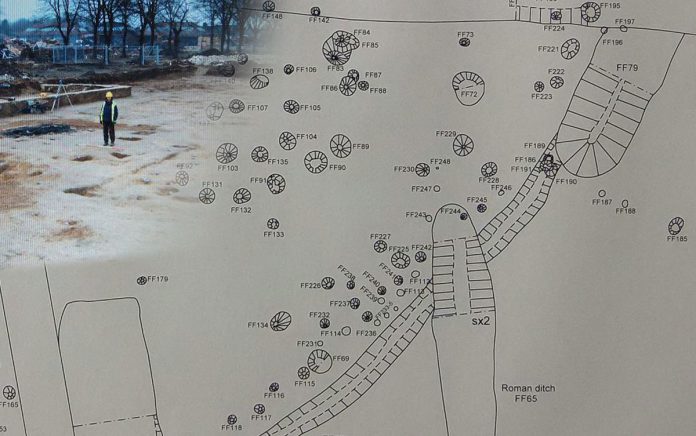The large excavation was conducted in 2011 and had been subdivided it into eleven sites (A-K), the report has had to wait for the specialist reports in order to be completed. Most of the barrack buildings were demolished and the area was cleared, and 85 evaluation trenches were machine excavated, followed with hand-excavation of the features identified during the evaluation trenching. Now, Howard is collecting all the results and interpreting them in our final report on the excavation.
The remarkable discoveries from the excavation have already been described on the web-site and in the Trust magazine: two Middle Iron Age round-houses, a previously unknown part of a large defensive Late Iron Age dyke, a hoard of 1,247 Roman coins which was probably buried in uncertain times in AD 271, and part of a cemetery which included two Germanic or Anglo-Saxon warrior burials, in which both individuals had been buried with a round shield on their chest and a spear beside them, and one also with a dagger in a belt around the waist.
However Site F produced evidence of a group of three small but interesting Iron Age enclosures (numbered 1-3). Interesting because their functions are not obvious and thus more difficult to interpret.
Three enclosures
The three enclosures seem to have been for holding stock animals, and so they would have been part of the extensive agricultural landscape of the oppidum. The the Iron Age stronghold was the area of Camulodunum, where the Roman town of Colchester was later built.
The Trust have been investigating this part of the oppidum, to the south of the modern town centre, since 2000, during the redevelopment of the old garrison, uncovering evidence of agricultural elements such as trackways and the ditches of field systems across the whole area. The linear features and post-holes which represent the three enclosures here, on Site F, provide us with quite detailed evidence.
Enclosure 1 was a small fenced area with what looks like a stock-control feature at the entrance. Enclosure 2 seems to have been a stock enclosure with fence posts. Enclosure 3 seems to have been defined by a wicker fence and to have had a small post-built structure within it, which is interpreted as having been an animal shelter. The three enclosures would have been used to corral stock animals, and the potential is that each is for a specific and different purpose.
An important Tribal Centre
Camulodunum was probably the most important stronghold in southern Iron Age Britain, and it was protected by the largest system of Late Iron Age (and, later, early Roman dykes) in Britain. A dyke was a defensive earthwork consisting of a large bank and ditch. The part of a dyke which we discovered at the Hyderabad and Meeanee Barracks site seems to be an eastward extension of the Berechurch Dyke, which was constructed north-south and protected Camulodunum from attack from the east. This part suggests that the dyke continued further north than we previously thought, turned east and continued towards the River Colne.
When the report is completed, it will be publish along with all the others available at the online library http://cat.essex.ac.uk/ .

Source: Colchester Archaeology Trust


